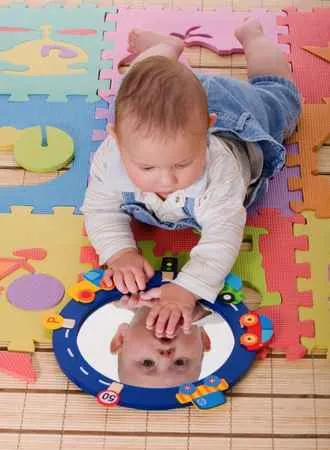Are you struggling to understand the importance of tummy time, or perhaps looking for effective ways to incorporate it into your baby’s routine? If so, you’re not alone. Many new parents grapple with the concept, often wondering about its significance and the best practices associated with it.
Fortunately, tummy time, when done correctly, can offer a plethora of benefits, aiding in your baby’s physical development and providing a foundation for essential motor skills.
As an expert in infant development and early childhood practices, I have crafted a comprehensive guide that breaks down the ins and outs of tummy time, ensuring your baby benefits maximally from each session.
Let’s delve into this essential practice and guide you towards creating an effective and enjoyable tummy time routine for your little one.
Key Takeaways on Tummy Time
- Tummy time is important for helping babies develop strong core muscles and reach developmental milestones.
- There are many different ways to do tummy time, from traditional methods to modified techniques using props and videos.
- With our tummy time tips and tricks, parents can troubleshoot common problems, make tummy time fun and engaging for their baby, and encourage healthy physical development.
Why is Tummy Time Important for Babies?
Many parents understand that tummy time provides numerous developmental benefits for their physical and cognitive development. Here are some of the main reasons why tummy time is so important:

Develops Strong Core Muscles
Tummy time helps babies develop strong core muscles, which are essential for proper posture and movement. As baby lies and push their legs forward, they gain proper head control, and upper body strength. It also helps them strengthen their neck muscles.
Prevents Flat Head Syndrome and Motor Delays
Tummy time also helps prevent flat head syndrome, a condition that can occurs when flat spots develop on the baby’s head after spending longer periods on their backs. Alternating between time on their back and tummy helps reduce the risk of developing this condition.
Promotes Cognitive Development
Tummy time promotes cognitive development by giving babies the opportunity to explore and interact with their environment, developing sensory and motor skills. It also helps improve their visual tracking skills as they learn to follow objects with their eyes.

Supports Developmental and Motor Milestones
Tummy time is essential for achieving other developmental milestones, such as hand-eye coordination, strengthened back muscles, reaching for objects, and even learning to babble and talk.
Incorporating tummy time into your baby’s daily routine can help them develop into strong and healthy individuals. By understanding the benefits of tummy time, you can ensure that your baby gets the most out of this essential activity.
Recommended Tummy Time Duration and Frequency
Experts recommend starting tummy time as soon as your baby comes home from the hospital and increasing it gradually over time. The American Academy of Pediatrics recommends at least 30-60 minutes of tummy time per day, spread out in short intervals throughout the day.
However, every baby is different, and it’s important to follow your baby’s cues and adjust the duration and frequency of tummy time to their individual needs.
How to Get Started
Tummy time is an essential activity for your baby’s growth and development, and there are many different positions you can try to make it fun and engaging, even if your baby hates tummy time. All these positions are comfortable for most babies.
Chest-to-Chest
Lie on your back with your legs bent and feet flat on the floor. Place your baby on your chest with their arms and legs tucked under their body. Talk to your baby and make eye contact to keep them engaged.

Football Hold
Hold your baby like a football with their tummy against your forearm. Use your other hand to support their head. You can also use a pillow to prop up their chest and make the position more comfortable.
Cross-Body Position
Hold your baby across your body with their head resting on your bicep. Use your other arm to support their body and keep them steady.
Eye-Level
This position involves propping your baby up on a pillow or cushion so they can look around at eye level.
Prop your baby up on a pillow or cushion so they can look around at eye level. Use toys or a mirror to keep them engaged and encourage them to lift their head.
Pillow Propping
This position involves propping your baby up on a pillow or cushion to support their upper body.
Prop your baby up on a pillow or cushion to support their upper body. Make sure the pillow is not too high, and your baby is comfortable.
Lap Soothe
This position involves sitting with your legs outstretched and your baby lying on their stomach across your lap.
Sit with your legs outstretched and your baby lying on their stomach. Use your hands to support their body and keep them steady.
Tips for Getting Started with Tummy Time Positions
- Start with short sessions of tummy time and gradually increase the duration as your baby gets more comfortable.
- Use toys or mirrors to keep your baby engaged and encourage them to lift their head.
- Make sure your baby is comfortable and adjust the position or cushioning as needed.
- Supervise your baby at all times during tummy time to ensure their safety and well-being.
How Often Should I Switch Tummy Time Positions?
It’s a good idea to switch up your baby’s tummy time positions every few minutes to keep them engaged and avoid discomfort. You can also try alternating between different positions throughout the day to provide variety and promote all-around development.
How to Do Tummy Time: Tips and Strategies for Success
Many parents want skip tummy time because its challenging. What they don’t know is that tummy time is important for the baby’s physical development. Sure, it can also be challenging, but it doesn’t need to be. There are many ways to make tummy time interesting for many babies.
Here are different tips to turn tummy time sessions from challenging to fun.
- Choose a safe surface for practicing tummy time.
- Place baby on their tummy on a soft, flat surface.
- Place a toy or colorful object in front of your baby to encourage them to lift their head.
- Get down on the floor with your baby and talk to them, make eye contact, and offer encouragement.
- Keep tummy time toys, mirrors, or other colorful toys close to your baby’s face.
- Sing songs, make silly noises, or play peek-a-boo to keep your newborn engaged.
- Get down on the floor with your baby and interact with them to make tummy time a bonding experience.
- Place your baby on top of your old exercise ball while holding them in position.
- Always remember that “tummy to play, back to sleep.”
Strategies for Overcoming Common Challenges and Difficulties
- Start tummy time early, especially during the first month. Lay baby on your tummy, then hold baby on eye level and talk to them during the early days of tummy time. Make funny faces to make your baby laugh or smile.
- Let your baby practice tummy time for brief periods. For instance, you can start with multiple sessions of three to five minutes at a time in a day. Gradually increase their time on the floor once you baby is comfortable with the activity.
- Use a nursing pillow or cushion such as a rolled-up towel or a soft blanket and place it under your baby’s chest.
- Carrying baby tummy down or face down when moving from one room to another is a good alternative to carrying your baby upright.
- Link tummy time to other routines such as diaper change.

When Should A Baby Start Tummy Time?
The American Academy of Pediatrics (AAP) recommends that babies start tummy time as early as possible, ideally within the first few days of life. You can start tummy time the moment you arrive home from the hospital.
It’s recommended that babies do tummy time for three to five minutes at a time, two to three times a day, gradually increasing the time as the baby gets older.
It’s important to note that some babies may not enjoy tummy time at first, but parents can make it more enjoyable by interacting with their baby, using toys or mirrors, and making sure the surface is comfortable.
Tummy time refers to the time a baby spends on their tummy while awake and supervised. Activities that do not count as tummy time include when a baby is on their tummy while sleeping, in a car seat, or a baby carrier.
Gradually Increasing Tummy Time Duration
It’s essential to gradually increase the duration of tummy time to prevent your baby from getting too tired or frustrated. Here are some baby tummy time tips:
- Place your baby tummy down onto your chest then move them onto the a flat surface with soft blanket. Begin with just a few minutes of tummy time per session, and gradually increase the duration by a minute or two every few days.
- Build up to 20-30 minutes a day: By the time your baby is three months old, they should be doing tummy time for around 20-30 minutes a day, spread out in shorter sessions.
- Follow your baby’s cues: If your baby is fussy or resistant to tummy time, take a break and try again later. Don’t force your baby to do tummy time if they are not comfortable or happy.
- Incorporate tummy time into your daily routine: Try to make tummy time a regular part of your baby’s daily routine. This will help your baby get used to the activity and make it easier to gradually increase the duration.
Tummy Time Activities: From Basic Positions to Interactive Play
Tummy time is a crucial activity for infants that can help promote their motor and sensory development. While it may seem simple, there are various activities you can do with your baby to make it more engaging and enjoyable. Here are some ideas for tummy time:
Basic Tummy Time Positions
The basic tummy time positions involve placing your baby on their stomach and allowing them to explore their surroundings. Here are some of the basic tummy time positions you can try with your baby:
- Prone position: This is the most basic tummy time position, where you lay your baby on their stomach with their arms in front of them. Encourage your baby to lift their head and look around.
- Side-lying position: This position involves placing your baby on their side with their arm extended in front of them. This position can help your baby develop their neck and shoulder muscles.
- Tummy-to-tummy position: This position involves lying down with your baby on their stomach on your chest. This can help your baby feel more secure and comfortable during tummy time.

Tummy Time with Toys
Adding toys to tummy time can make it more engaging and stimulating for your baby. You can see them reaching and grabbing toys. Here are some toy ideas you can use during tummy time:
- Wrist rattles, wooden spoons, shakers and other noise makers that make sounds when shaken can provide great entertainment and help develop your baby’s hand-eye coordination and visual tracking. Put them in front of your baby.
- Soft blankets and books with bright colors and bold patterns can capture your baby’s attention and promote visual perception.
- Teething toys can provide relief for your baby’s teething discomfort while also encouraging them to reach and grasp.
- Place your babies on baby gyms that provide instant entertainment through a variety of toys.
- You can provide your baby with an entertaining activity by placing a shallow tray, such as an oven tray, filled with water in front of them. Add some rubber ducks and other bath toys to the water and your baby can enjoy splashing their hands and observing the ducks float.
- At an early age, a baby’s eyes are only able to detect differences between black and white and not colors. To provide visual stimulation and entertainment for your baby, you can place a black and white book or picture approximately 8-12 inches from their face.
- Regardless of what toys you choose, move them from side by side in front of your baby’s face.
Tummy Time with Mirrors
Tummy time with mirrors can be a fun way for your baby to explore their own reflection and develop their visual perception. Here are some tips for incorporating mirrors into tummy time:
- Make sure the mirror you use is child-safe and unbreakable.
- Place the mirror at eye level for your baby so they can see their reflection easily.
- Talk to your baby about their reflection and encourage them to reach and touch the mirror.

Tips for Successful Tummy Time: From Starting Slowly to Making It Enjoyable
Tummy time is an essential activity for infants that can help promote their motor and sensory development. However, it can be challenging for some babies to adjust to tummy time and stay engaged.
Start Slowly and Gradually Increase Time
Starting slowly and gradually increasing tummy time duration is crucial for your baby’s comfort and success during tummy time. Here are some tips for starting slowly and increasing tummy time duration:
- Start with just a few minutes per session and gradually increase the duration by a minute or two every few days.
- Be consistent. Incorporate tummy time into your baby’s routine and be consistent with the amount of time spent on tummy time each day.
- Keep eye contact at all times during the activity.
Make Tummy Time Enjoyable with Toys and Games
Having toys to explore during tummy time can help keep your baby engaged and stimulated. Here are some ideas for making tummy time enjoyable with toys and games:
- Engage in sensory play. Choose toys with bright colors and bold patterns that will capture your baby’s attention and stimulate their visual perception.
- Toys that make noise, such as rattles or shakers, can help your baby develop hand-eye coordination and auditory skills.
- Encourage your baby to reach for and grasp toys, pom poms or play peek-a-boo.
Use a Comfortable Surface
Using a comfortable surface is important for your baby’s safety and comfort. Here are some tips for choosing a comfortable surface:
- Place baby on a play mat or a blanket as a soft and safe surface.
- Avoid hard or uneven surfaces. Hard or uneven surfaces can be uncomfortable and unsafe for your baby. Always use a soft and safe surface.
- Consider using a mat designed specifically for tummy time and can provide extra comfort and support for your baby.
- Secure blankets so they don’t slide when your baby moves.
Supervise Your Baby During Tummy Time
It’s important to supervise your baby during tummy time to ensure their safety and comfort. Here are some tips for supervising your baby during tummy time:
- Stay close to your baby and keep an eye on them at all times.
- Use your hands to support your baby’s chest and help them lift their head and upper body.
- If your baby becomes fussy or uncomfortable, tell them you head them and gently roll them from tummy to back.
Tummy Time Tips and Tricks for Newborns: Making It Fun and Enjoyable
Introducing tummy time is an important for many babies, but it can be challenging to know where to start. Here are some tips and tricks for starting tummy time with a newborn baby and making it a pleasant experience.

How to Start Tummy Time with a Newborn Baby
- Begin by laying your baby on their tummy for a few minutes at a time, two to three times a day.
- Start with short tummy time sessions, gradually increasing the time as your baby becomes more comfortable.
- Try doing tummy time after a diaper change or when your baby is alert and awake.
- Carry baby tummy down when moving from one room to another. Nestle baby close to your own body to help them get used to tummy time.
Creative Ways for a Happy Tummy Time
- Get down on the floor with your baby, face to face, and encourage eye contact and get some eye level smile.
- Place toys and a mirror in front of your baby’s face.
- Place a soft blanket under your baby’s chest to prop them up and make tummy time more comfortable.
- Sing or talk to your baby to make the experience more enjoyable.
- Place baby belly down on an exercise ball. Put a blanket on top and hold your baby while in this tummy time position.
Modified Tummy Time Techniques for Newborns
- Place your baby on your chest, tummy-to-tummy, or over your lap, supporting their head and neck.
- Hold your baby in a football hold with their belly facing down.
- Place your baby on a pillow, propped up on their belly.
- Help strengthen your baby’s arms and improve neck control with baby push-ups.
It’s important to remember that some babies may not enjoy tummy time at first, but with patience and practice, they will become more comfortable. If your baby continues to resist tummy time, consult with your pediatrician for further guidance.
Tummy time is an important activity for newborns, but it can be challenging to know where to start.
Tummy Time Tips and Tricks for 3-Month-Olds: Engaging and Entertaining Your Baby
Tummy time is an important activity for 3-month-old babies, as they continue to develop their physical and cognitive skills. Here are some tips and tricks for different ways to do tummy time with a 3-month-old baby, strategies to keep your baby engaged and entertained, and tummy time positions for a 3-month-old baby.
Different Ways to Do Tummy Time with a 3-Month-Old Baby
- Place your baby on a play mat with toys or a mirror to encourage them to lift their head and engage with their environment.
- Use a nursing pillow or soft blanket to prop your baby up on their belly, making tummy time more comfortable and enjoyable.
- Hold your baby in a football hold with their belly facing down, supporting their head and neck.
Tummy Time Strategies to Keep Your Baby Engaged and Entertained
- Make tummy time a fun and interactive experience by getting down on the floor with your baby and playing together.
- Use toys or a mirror to encourage your baby to lift their head and engage with their environment.
- Babies love to the voices of their parents so sing or talk to your littles ones during diaper changes or bath time.
Tummy Time Positions for a 3-Month-Old Baby
- Place your baby on their tummy with their arms and legs extended, encouraging them to push up on their forearms.
- Place your baby tummy down across your lap and make tummy time more comfortable.
- Hold your baby in a seated position, supporting their chest and belly with your hands.
Most babies will get used to tummy time in no time, but others might take a while to get fully adjusted to their new routine.
Different Ways to Do Tummy Time: Traditional, Modified, and with Props
Tummy time is an essential activity for babies, promoting strong core muscles and supporting developmental milestones. However, there are different ways to do tummy time to keep your baby engaged and comfortable. Here are some variations to consider:
Traditional Tummy Time
Traditional tummy time involves placing your baby on their stomach on a flat surface, such as a play mat or blanket. Here’s how to do it:
How to Do Traditional Tummy Time
- Lay your baby on their stomach on a flat surface.
- Place a rolled-up towel or blanket under their chest to prop them up and make them more comfortable.
- Encourage your baby to lift their head and look around by using toys, a mirror, or interacting with them.
Tips for Making Traditional Tummy Time More Comfortable for Your Baby
- Start with short sessions, gradually increasing the time as your baby gets more comfortable.
- Choose a time when your baby is alert and awake, rather than when they are tired or hungry.
- Place a soft blanket or towel under their arms to prevent them from slipping.
Variations on Traditional Tummy Time
- Place your baby on your chest, tummy-to-tummy, or over your lap, supporting their head and neck.
- Hold your baby in a football hold with their belly facing down.
- Place your baby on a nursing pillow, propped up on their belly.
Modified Tummy Time
Modified tummy time involves using different positions to achieve the benefits of tummy time without placing your baby directly on their stomach.
Explanation of Modified Tummy Time and Its Benefits
Modified tummy time is beneficial for babies who may not enjoy traditional tummy time or have reflux or other medical conditions. It can also help prevent flat head syndrome.
How to Do Modified Tummy Time
- Hold firmly in a seated position, supporting their chest and belly with your hands.
- Lay your baby on their back and gently move their legs as if they are pedaling a bicycle.
- Place your baby on their side for brief periods, propped up with a rolled-up towel or blanket.
Precautions to Take When Doing Modified Tummy Time
- Always supervise your baby during modified tummy time.
- Avoid placing your baby in a tummy time position that may obstruct their breathing.
- Consult with your pediatrician before trying modified tummy time, especially if your baby has a medical condition.
- Don’t do tummy time when your baby is sleep deprived.
- If your baby falls asleep while doing tummy time, roll them to their backs. Remember, “back to sleep, tummy to play.”
Tummy Time with Props
Using props during tummy time can make the experience more engaging and enjoyable for your baby.
Tummy Time Techniques Using Props
- Use a mirror to encourage your baby to engage with their environment.
- Place toys or a play gym within reach to encourage reaching and grasping.
- Use a yoga ball or cushion to create an unstable surface, promoting balance and strengthening core muscles.
Benefits of Using Props for Tummy Time
- Props can make tummy time more enjoyable and engaging for your baby.
- They can also promote the development of sensory and motor skills.
Tummy Time Positions Using Props
- Place your baby on their stomach with a mirror or toys in front of them to encourage them to lift their head.
- Place your baby on their back and hold toys above them, encouraging reaching and grasping.
- Use a rolled-up towel or cushion under your baby’s chest to prop them up and make tummy time more comfortable.
By considering different ways to do tummy time, including traditional, modified, and with props, you can make the experience more engaging and enjoyable for your baby.
Addressing Common Concerns
While tummy time is an essential activity for babies, it’s not always easy. Here are some common problems parents face during tummy time and tips for helping your baby enjoy the experience.
Common Problems Parents Face During Tummy Time
- Your baby cries or fusses during tummy time.
- Your baby refuses to lift their neck and head or engage with their environment.
- Your baby has difficulty staying on their stomach or becomes restless.
- You’re concerned about your baby’s development or progress during tummy time.
Tips for Helping Your Baby Enjoy Tummy Time
- Start with short sessions, gradually increasing the time as your baby gets more comfortable.
- Choose a time when your baby is alert and awake, rather than when they are tired or hungry.
- Make tummy time a fun and interactive experience by getting down on the floor with your baby and playing together.
How to Address Concerns About Your Baby’s Development During Tummy Time
- If you’re concerned about your baby’s progress during tummy time, consult with your pediatrician for guidance.
- Your pediatrician may recommend physical therapy or other interventions if your baby is not meeting developmental milestones.
Alternative Positions
If you’re searching for other ways for tummy, perhaps a different tummy time position may work for you and your baby.
Traditional tummy time positions don’t work for all babies, but there are alternative positions that can be just as effective in promoting muscle development and growth. These positions offer a different way for babies to reach important developmental milestones.
Side-Lying
Side-lying is a great alternative position for babies who don’t tolerate traditional tummy time positions well. To perform side-lying, place your baby on their side with a rolled-up towel or blanket behind their back for support. This position helps develop neck and shoulder muscles and is also good for babies who have reflux.
Make sure your baby doesn’t sped too much time on one side. Slowly lay them on the bed while awake turn them to the other side.

Supported Sitting
Supported sitting is another alternative position that can help babies develop their necks and shoulders. To perform supported sitting, sit your baby up with support from pillows or cushions behind their back. This position helps babies learn to control their head movements and can also help with strengthen back muscles, balance and coordination.
Standing
The standing position is a great way to help babies strengthen their leg and core muscles. To perform the standing position, hold your baby under their arms and let them put weight on their legs. This position helps develop leg strength and coordination, and can also help with balance and posture.

Babywearing
Babywearing refers to the practice of carrying a baby using a special carrier or wrap that allows for hands-free movement. It provides a safe, convenient, and comfortable way to carry and care for a baby. Babywearing provides numerous benefits for babies, including increased bonding with caregivers, improved physical and emotional development, and reduced crying and fussiness.
Playtime and Exercise
Playtime and exercise are essential for promoting muscle development in babies. By providing a variety of toys and activities on the floor, you can help your baby develop their muscles and coordination in a fun and engaging way.

Using different toys and activities
Placing toys close to your baby encourages them to reach out for them and move side to side.
Tummy time play mats and exercise balls can help babies strengthen their tummy and neck muscles. You can also place your baby’s chest against a soft rolled-up blanket or nursing pillow.
Play gyms and mobiles can encourage many babies to reach and grasp, which helps develop hand-eye coordination. Soft blocks and rattles can help babies develop their fine motor skills.
You can also get your old exercise ball out and put your baby while on their tummy on top. Place a blanket on the ball to make it cozy for your baby. Make sure you hold your her to keep her in a secure position even if the baby moves.
Can Alternatives Replace Traditional Tummy Time?
While these alterative can be effective in promoting muscle development, traditional tummy time is still an important part of a baby’s development. It’s recommended to use a combination of both traditional and alternative baby tummy time activities for the best results.
Regardless which methods you use, always make sure to roll her onto her back if your baby falls asleep. You can easily remember this by taking a mental note — “tummy to play, back to sleep.”
Frequently Asked Questions About Tummy Time
What if My Baby Hates Tummy Time?
Some babies may not enjoy tummy time at first, but with patience and practice, they will become more comfortable.
Try different positions or use toys or a mirror to make the experience more enjoyable.
Can I Do Tummy Time with My Baby After They Have Eaten?
It’s best to wait at least 30 minutes after your baby has eaten before doing tummy time to prevent spitting up or choking.
How Long Should Tummy Time Be?
The American Academy of Pediatrics (AAP) recommends that babies start tummy time as early as possible, ideally within the first few days of life.
It’s recommended that babies do tummy time for three to five minutes at a time, two to three times a day, gradually increasing the time as the baby gets older.
Can Tummy Time Help Prevent Flat Head Syndrome?
Yes, tummy time can help prevent flat head syndrome by promoting even pressure on your baby’s head.
Is It Safe to Do Tummy Time with a Newborn Baby?
Yes, it’s safe to do tummy time with a newborn baby as long as it is supervised and done on a flat surface. It’s really important to help build up their neck and shoulder muscles.
How Can I Make Tummy Time More Fun for My Baby?
Use toys, a mirror, or interact with your baby to make the experience more enjoyable.
Get down on the floor with your baby and play together.
How Often Should I Do Tummy Time with My Baby?
The AAP recommends that babies do tummy time for three to five minutes at a time, two to three times a day, gradually increasing the time as the baby gets older.





